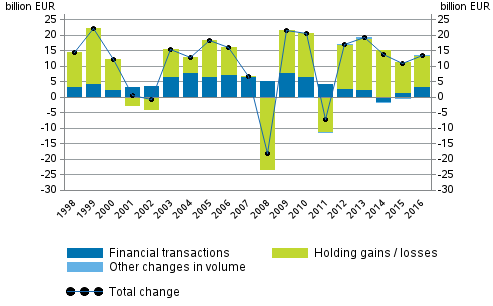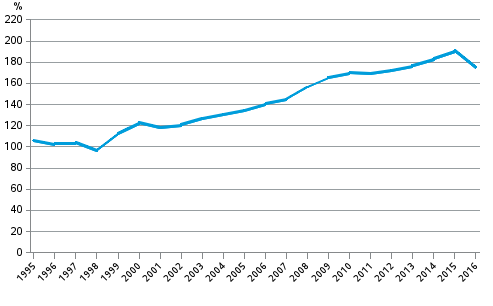1. Holding gains behind the growth in households’ net financial assets for the fifth year in a row
Households’ financial assets grew by EUR 13 billion during 2016 rising to EUR 293 billion. For the fifth year in a row, a majority of the growth in financial assets came from holding gains. This was particularly caused by the continued rise in stock market prices. In 2016, EUR ten billion was generated in holding gains, while households’ net investments in financial assets amounted to EUR three billion.
The overall development of households’ financial assets and liabilities continued as favourable in 2016. The difference between financial assets and liabilities, i.e. net financial assets, continued growing for the fifth year in a row. In 2016, net financial assets grew by more than EUR six billion to EUR 139 billion, even though households’ debts grew by more than EUR seven billion during the same period.
Figure 1. Change in financial assets of households, EUR billion

Households’ net investments in financial assets recovered somewhat from the lower level seen in the past years. Most net investments were made in deposits, slightly over EUR three billion. Net investments in quoted shares turned slightly positive in 2016 having been around EUR 0.5 billion negative in 2015. The popularity of mutual fund shares remained on the previous year’s level as households invested around EUR 0.5 billion of their assets in them.
In terms of deposits, the shift in focus from fixed-term deposits to cash deposits that has been visible for several years continued. Households withdrew EUR two billion from fixed-term deposits in 2016, while their cash deposits increased by EUR five billion.
Overall, households’ financial assets amounted to EUR 293 billion at the end of 2016. Of these, EUR 83 billion were deposits, EUR 75 billion unquoted shares and equity, EUR 60 billion insurance and pension technical reserves, EUR 36 billion quoted shares, and EUR 22 billion mutual fund shares. The value of other financial assets held by households was EUR 17 billion. Households’ shares in housing corporations are not included in households’ financial assets in the financial accounts as they are part of other assets or non-financial assets.
The growth in households’ debts continued at the tune of the past couple of years. Households’ loan debts increased by EUR five billion during 2016, reaching nearly EUR 143 billion at the end of the year. The indebtedness rate, i.e. the proportion of loans relative to disposable income, rose by 2.2 percentage points to 126.4 per cent. As a result of holding gains, households' financial assets increased more than their debts. Thus, households' net financial assets grew by over EUR six billion to EUR 139 billion.
1.1. General government’s financial position improved slightly
General government's financial position improved during the year by over EUR two billion. Net financial assets rose to EUR 114 billion. Among general government, central government increased its debt but the investment income of employment pension schemes exceeded the indebtedness pace of central government. Employment pension schemes were responsible for a majority of the increase in general government's net financial assets. Local government's net financial position remained almost on level with the previous year.
The deterioration in central government's net financial position that began in 2008 continued still in 2016. The decrease continued at the same pace as in 2015, by good EUR four billion. At the end of 2016, central government's net financial assets stood at EUR -67 billion. The drop in the net financial position was caused by increased indebtedness of central government as its net financial assets remained at last year’s level. Central government debt increased mainly on account of new bonds it issued.
Employment pension schemes’ net financial position has improved by EUR 50 billion or 38 per cent over the past five years. Employment pension schemes’ net financial assets grew from EUR 178 billion to EUR 185 billion during 2016. The growth was based in particular on considerable holding gains from mutual fund shares and quoted shares, as employment pension schemes increased their net investments by as little as EUR 1.6 billion. Any additional investments mainly focused on these assets as well. The share of debt securities in the investment portfolio decreased slightly as employment pension schemes withdrew around EUR three billion on net from them.
1.2. Non-financial corporations decreased debt financing
Non-financial corporations' debt financing decreased during 2016 by EUR 27 billion. Debt financing refers to the total of loan debts and financing in the form of debt securities. Over the year, non-financial corporations' debt financing decreased from EUR 244 billion to EUR 217 billion. Especially non-financial corporations’ loan debt decreased as their level dropped by EUR 24 billion.
1.3. Strong growth in domestic mutual funds continued
The strong growth in domestic mutual funds continued for the fifth year in a row. Growth in 2016 amounted to EUR 11 billion. Slightly over one-half of the growth was generated through net investments while the other half consisted of holding gains from funds. Especially foreign bodies invested in domestic mutual funds during 2016.
1.4. Foreign holdings in Finnish quoted shares was exactly one-half
Foreign net investments to Finland decreased by EUR eight billion. The biggest decreases were seen in debt securities as foreign bodies’ transactions in them decreased by EUR 13 billion. There was a shift in deposits from other deposits to transferable deposits. Changes in deposit assets and liabilities are mainly linked to operations between financial institutions.
Foreign investors increased their holdings in Finland especially in quoted shares last year. A total of EUR 13 billion in foreign money flowed to them. At the end of the year, the value of foreign share holdings in Finnish quoted shares was close on EUR 98 billion. The proportion of foreign ownership of the value of Finnish quoted shares was exactly one-half or 50 per cent.
Of foreign investment instruments, particularly mutual fund shares were favoured by Finns in 2016. Finns owned EUR 115 billion in foreign investment fund shares while the level for domestic investment fund shares was EUR 93 billion. Finnish units held nearly EUR 67 billion in foreign quoted shares at the end of the year. Finnish units’ level of holdings in domestic quoted shares in turn stood at EUR 97 billion.
1.5. Private sector debt decreased
Private sector debt fell by EUR 22 billion during 2016. Simultaneously, the GDP share of the debt decreased by 15.4 percentage points to 175.6 per cent. Private sector debt comprises the loan debts and debts in the form of debt securities of non-financial corporations, households and non-profit institutions serving households.Figure 2. Non-consolidated private sector debt as percentage of GDP

�
Source: Financial Accounts, Statistics Finland
Inquiries: Peter Parkkonen 029 551 2571, rahoitus.tilinpito@stat.fi
Director in charge: Ville Vertanen
Updated 13.7.2017
Official Statistics of Finland (OSF):
Financial accounts [e-publication].
ISSN=1458-8145. 2016,
1. Holding gains behind the growth in households’ net financial assets for the fifth year in a row
. Helsinki: Statistics Finland [referred: 9.12.2025].
Access method: http://stat.fi/til/rtp/2016/rtp_2016_2017-07-13_kat_001_en.html

